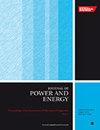Numerical investigation on conjugate heat transfer characteristics of film and vortex composite cooling under rotating conditions
IF 1.1
4区 工程技术
Q3 ENGINEERING, MECHANICAL
Proceedings of the Institution of Mechanical Engineers, Part A: Journal of Power and Energy
Pub Date : 2023-06-27
DOI:10.1177/09576509231182227
引用次数: 0
Abstract
This paper numerically investigates the vortex and film composite cooling performance under rotating conditions. The cooling performance of the adiabatic and conjugate models is compared under the range of 0–4000 r/min. The conjugate model contains the fluid region: the cascade, the film holes, and the internal vortex cooling chamber, as well as the solid region: the blade material between the internal flow and the mainstream flow. The adiabatic model is established by removing the blade material part in the conjugate model. The dimensionless temperature θ inversely proportional to the temperature is adopted. Results show that the blade leading edge temperature doesn’t vary linearly with the rotating speed. The stagnation line of the mainstream flow on the blade leading edge moves from the pressure surface to the suction surface. The maximum θ appears at 1500 r/min when the stagnation line stays certainly on the row of film holes located on the pressure surface and is 7.86% higher than the minimum θ. The minimum θ appears at 2500 r/min when the stagnation line stays on the position between the rows of film holes. The distribution of θ is much uniform, and the value of θ is much higher in the conjugate cases than the adiabatic cases due to the heat conduction through the blade material. The highest aerodynamic parameter appears at 2000 r/min due to its relatively low blade leading edge temperature and low coolant consumption and is 41% higher than the aerodynamic parameter at 0 r/min.旋转条件下膜涡复合冷却耦合换热特性的数值研究
本文对旋转条件下涡膜复合冷却性能进行了数值研究。在0 ~ 4000 r/min范围内,比较了绝热模型和共轭模型的冷却性能。共轭模型包含流体区域:叶栅、膜孔和内部涡冷却室,以及固体区域:内部流和主流流之间的叶片材料。通过去除共轭模型中的叶片材料部分,建立了叶片的绝热模型。采用无因次温度θ与温度成反比。结果表明,叶片前缘温度不随转速线性变化。主流流动在叶片前缘的滞止线由压力面向吸力面移动。最大θ值出现在1500 r/min时,当滞止线固定在压力面上的膜孔排上时,θ值比最小θ值高7.86%。当滞止线停留在膜孔排之间的位置时,θ在2500 r/min时出现最小值。由于叶片材料的热传导作用,θ的分布很均匀,在共轭情况下θ的值比绝热情况大得多。由于相对较低的叶片前缘温度和较低的冷却剂消耗,2000 r/min时气动参数最高,比0 r/min时气动参数高41%。
本文章由计算机程序翻译,如有差异,请以英文原文为准。
求助全文
约1分钟内获得全文
求助全文
来源期刊

CiteScore
3.30
自引率
5.90%
发文量
114
审稿时长
5.4 months
期刊介绍:
The Journal of Power and Energy, Part A of the Proceedings of the Institution of Mechanical Engineers, is dedicated to publishing peer-reviewed papers of high scientific quality on all aspects of the technology of energy conversion systems.
 求助内容:
求助内容: 应助结果提醒方式:
应助结果提醒方式:


